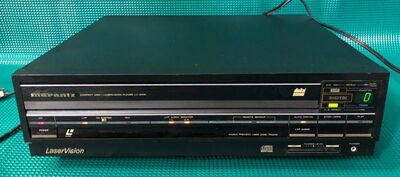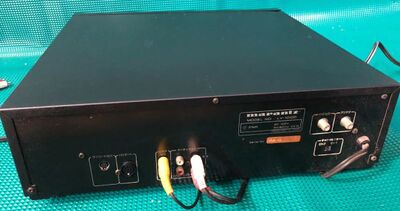Marantz LV-10CD: Difference between revisions
Jump to navigation
Jump to search
(Created page with "{{LaserDisc Player |manufacturer=Marantz |cx=No }}") |
No edit summary |
||
| Line 1: | Line 1: | ||
{{LaserDisc Player | {{LaserDisc Player | ||
|manufacturer=Marantz | |manufacturer=Marantz | ||
|releasedate=1986 | |||
|country=Japan | |||
|altmodels=Pioneer CLD-7 | |||
|colorsystem=NTSC | |||
|formats=LD, LD 20cm, CD | |||
|cx=No | |cx=No | ||
|inputvolts=100 | |||
|powerfreq=50, 60 | |||
|wattage=44 | |||
|frontimagefile=Marantz LV-10CD frontpanel.jpg | |||
|rearimagefile=Marantz LV-10CD rearpanel.jpg | |||
|compositeout=1 RCA | |||
|vhfout=1 F-Type | |||
|stereoout=2 RCA | |||
}} | }} | ||
==Other Information== | |||
Can be connected to a Japanese MSX1 computer using the 8-pin U-DIN connector. | |||
Latest revision as of 01:04, 21 October 2020
| Release Info | |
|---|---|
| Manufacturer | Marantz |
| Release Date | 1986 |
| Country | Japan |
| Color Encoding System | NTSC |
| Features | |
| Playable Disc Formats | LD, LD 20cm, CD |
| Playable LaserDisc Modes | |
| Both-Side Play | None |
| CX Noise Reduction | No |
| Video Characteristics | |
| Horizontal Resolution (TVL) | |
| Video Signal-to-Noise Ratio | |
| Laser Type | |
| Laser Wavelength | |
| Digital Video Processor | None |
| Analog Audio Characteristics | |
| Frequency Response | |
| Signal-to-Noise Ratio | |
| Digital Audio Characteristics | |
| Frequency Response | |
| Signal-to-Noise Ratio | |
| Power Characteristics | |
| Input Voltage | 100V |
| Power Frequency | 50, 60Hz |
| Power Consumption | 44W |
| Physical Characteristics | |
| Dimensions (W x H x D) | |
| Weight | |
| Loading Belt Part No. | |
| Accessories | |
| Remote Control | |
Clone Model Numbers/Rebadges
Manuals
Technical Data References
Other Information
Can be connected to a Japanese MSX1 computer using the 8-pin U-DIN connector.











